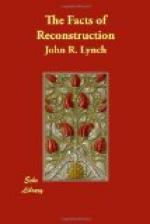CHAPTER V
THE CONTEST FOR SPEAKER OF THE MISSISSIPPI HOUSE OF REPRESENTATIVES
The elections being over, and a Republican majority in both branches of the Legislature being assured, Governor Alcorn was then prepared to vacate the office of Governor, to turn over the administration of State affairs to Lieutenant-Governor Powers and to proceed to Washington so as to be present at the opening session of Congress on the first Monday in December when he would assume his duties as a United States Senator.
The Legislature was to meet the first Monday in the following January,—1872. As soon as the fact was made known that the Republicans would control the organization of the House, the Speakership of that body began to be agitated. If Speaker Warren had been reelected he would have received the Republican caucus nomination without opposition, but his defeat made it necessary for a new man to be brought forward for that position. A movement was immediately put on foot to make me the Speaker of the House.
Upon a careful examination of the returns it was found that of the one hundred fifteen members of which the House was composed there were seventy-seven whites and thirty-eight colored. Of the seventy-seven whites, forty-nine had been elected as Democrats and twenty-eight as Republicans. The thirty-eight colored men were all Republicans. It will thus be seen that, while in the composition of the Republican caucus there were ten more colored than white members, yet of the total membership of the House there were thirty-nine more white than colored members. But in the organization of the House, the contest was not between white and colored, but between Democrats and Republicans. No one had been elected,—at least on the Republican side,—because he was a white man or because he was a colored man, but because he was a Republican. After a preliminary canvass the fact was developed that the writer was not only the choice of the colored members for Speaker of the House, but of a large majority of the white Republican members as well. They believed,—and voted in accordance with that belief both in the party caucus and in the House,—that the writer was the best-equipped man for that responsible position. This fact had been demonstrated to their satisfaction during the two sessions of the preceding Legislature.
The nomination of the writer by the House Republican caucus for Speaker was a foregone conclusion several weeks before the convening of the Legislature. With a full membership in attendance fifty-eight votes would be necessary to perfect the organization. When the Republican caucus convened sixty members were present and took part in the deliberations thereof. Four of the Republicans-elect had not at that time arrived at the seat of government. The two Independents from Carroll refused to attend the caucus, but this did not necessarily mean that they would not vote for the candidates thereof in the organization of the House. But since we had sixty votes,—two more than were necessary to elect our candidate,—we believed that the organization would be easily perfected the next day, regardless of the action of the members from Carroll County.




